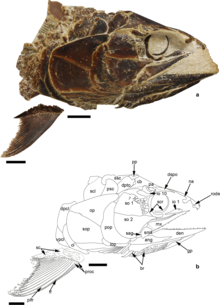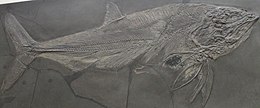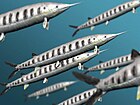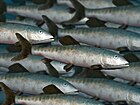Pachycormus (fish)

| Pachycormus Temporal range:
| |
|---|---|

| |

| |
| Scientific classification | |
| Domain: | Eukaryota |
| Kingdom: | Animalia |
| Phylum: | Chordata |
| Class: | Actinopterygii |
| Order: | †Pachycormiformes |
| Family: | †Pachycormidae |
| Genus: | †Pachycormus Agassiz, 1833 |
| Type species | |
| †Pachycormus macropterus (originally Elops macropterus) (de Blainville 1818)
| |
Pachycormus (from Greek: παχύς pakhús, 'thick' and Greek: κορμός kormós 'trunk')[1] is an extinct genus of pachycormiform ray-finned fish known from the Early Jurassic (Toarcian stage) of Europe. The type species P. macropterus was first named as a species of Elops by Henri Marie Ducrotay de Blainville in 1818, it was placed into the newly named genus Pachycormus by Louis Agassiz in 1833. Fossils have been found in marine deposits from France, Germany and England. Pachycormus has recently been considered monotypic, only containing P. macropterus, with other species considered junior synonyms of the former,[2] though this has subsequently been questioned.[3] Pachycormus has generally been considered basal among Pachycormiformes, with a recent phylogeny finding it to be the second most basal pachycormiform after Euthynotus.[2] It grew up to 1 m (3.5 ft) in length.[2] The teeth are short and designed for grasping. Its ecology has been interpreted as that of a generalist predator.[3] Stomach contents indicate that its diet included cephalopods (including vampyropods, belemnites and ammonites), and small fish, including juvenile Pachycormus.[4]
References[edit]
- ^ Roberts, George (1839). An etymological and explanatory dictionary of the terms and language of geology. London: Longman, Orme, Brown, Green, & Longmans. p. 129. Retrieved 31 December 2021.
- ^ a b c Wretman, Lovisa; Blom, Henning; Kear, Benjamin P. (2016-09-02). "Resolution of the Early Jurassic actinopterygian fish Pachycormus and a dispersal hypothesis for Pachycormiformes". Journal of Vertebrate Paleontology. 36 (5): e1206022. Bibcode:2016JVPal..36E6022W. doi:10.1080/02724634.2016.1206022. ISSN 0272-4634. S2CID 89338085.
- ^ a b Cawley, John J.; Kriwet, Jürgen; Klug, Stefanie; Benton, Michael J. (2018-09-20). "The stem group teleost Pachycormus (Pachycormiformes: Pachycormidae) from the Upper Lias (Lower Jurassic) of Strawberry Bank, UK". PalZ. 93 (2): 285–302. doi:10.1007/s12542-018-0431-7. hdl:1983/1a98e5d7-53a8-4f69-b1cd-64c284303128. ISSN 0031-0220. S2CID 91258610.
- ^ Cooper, Samuel L. A. (2023-05-04). "Cannibalism in the Early Jurassic bony fish Pachycormus macropterus (Teleosteomorpha: Pachycormiformes) and its paleoecological significanceCitation for this article: Cooper, S. L. A. (2024) Cannibalism in the Early Jurassic bony fish Pachycormus macropterus (Teleosteomorpha: Pachycormiformes) and its paleoecological significance. Journal of Vertebrate Paleontology . https://doi.org/10.1080/02724634.2023.2294000". Journal of Vertebrate Paleontology. 43 (3). doi:10.1080/02724634.2023.2294000. ISSN 0272-4634.
{{cite journal}}: External link in|title=
- Fossils (Smithsonian Handbooks) by David Ward (page 214)







